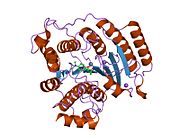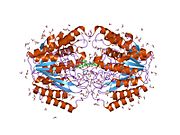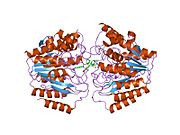HDAC8
Ensembl | |||||||||
|---|---|---|---|---|---|---|---|---|---|
| UniProt | |||||||||
| RefSeq (mRNA) |
| ||||||||
| RefSeq (protein) |
| ||||||||
| Location (UCSC) | Chr X: 72.33 – 72.57 Mb | Chr X: 101.33 – 101.55 Mb | |||||||
| PubMed search | [3] | [4] | |||||||
| View/Edit Human | View/Edit Mouse |
Histone deacetylase 8 is an enzyme that in humans is encoded by the HDAC8 gene.[5][6][7]
Function
Histones play a critical role in transcriptional regulation, cell cycle progression, and developmental events. Histone acetylation / deacetylation alters chromosome structure and affects transcription factor access to DNA. The protein encoded by this gene belongs to class I of the histone deacetylase/acuc/apha family. It has histone deacetylase activity and represses transcription when tethered to a promoter.[7]
Histone deacetylase 8 is involved in skull morphogenesis[8] and metabolic control of the ERR-alpha / PGC1-alpha transcriptional complex.[9]
Clinical significance
HDAC8 has been linked to number of disease states notably to
Interactions
- ERR-alpha.[9]
See also
References
- ^ a b c GRCh38: Ensembl release 89: ENSG00000147099 – Ensembl, May 2017
- ^ a b c GRCm38: Ensembl release 89: ENSMUSG00000067567 – Ensembl, May 2017
- ^ "Human PubMed Reference:". National Center for Biotechnology Information, U.S. National Library of Medicine.
- ^ "Mouse PubMed Reference:". National Center for Biotechnology Information, U.S. National Library of Medicine.
- PMID 10756090.
- S2CID 12335886.
- ^ a b "Entrez Gene: HDAC8 histone deacetylase 8".
- PMID 19605684.
- ^ PMID 20484414.
- S2CID 30268983.
- PMID 18256683.
- PMID 19118036.
- PMID 23547652.
- PMID 23116147.
- PMID 31819097.
Further reading
- Waltregny D, De Leval L, Glénisson W, Ly Tran S, North BJ, Bellahcène A, Weidle U, Verdin E, Castronovo V (2004). "Expression of histone deacetylase 8, a class I histone deacetylase, is restricted to cells showing smooth muscle differentiation in normal human tissues". Am J Pathol. 165 (2): 553–64. PMID 15277229.
- Glénisson W, Waltregny D, Tran SL, North BJ, Verdin E, Colige A, Castronovo V (June 2005). "Histone deacetylase HDAC8 associates with smooth muscle alpha-actin and is essential for smooth muscle cell contractility". FASEB J. 19 (8): 966–8. S2CID 12006005.
- Wedel T, Van Eys GJ, Waltregny D, Glénisson W, Castronovo V, Vanderwinden JM (2006). "Novel smooth muscle markers reveal abnormalities of the intestinal musculature in severe colorectal motility disorders". Neurogastroenterol. Motil. 18 (7): 526–38. S2CID 58462.
- Verdin E, Dequiedt F, Kasler HG (2003). "Class II histone deacetylases: versatile regulators". Trends Genet. 19 (5): 286–93. PMID 12711221.
- Hu E, Chen Z, Fredrickson T, et al. (2000). "Cloning and characterization of a novel human class I histone deacetylase that functions as a transcription repressor". J. Biol. Chem. 275 (20): 15254–64. PMID 10748112.
- Buggy JJ, Sideris ML, Mak P, et al. (2001). "Cloning and characterization of a novel human histone deacetylase, HDAC8". Biochem. J. 350 (1): 199–205. PMID 10926844.
- Amann JM, Nip J, Strom DK, et al. (2001). "ETO, a target of t(8;21) in acute leukemia, makes distinct contacts with multiple histone deacetylases and binds mSin3A through its oligomerization domain". Mol. Cell. Biol. 21 (19): 6470–83. PMID 11533236.
- Strausberg RL, Feingold EA, Grouse LH, et al. (2003). "Generation and initial analysis of more than 15,000 full-length human and mouse cDNA sequences". Proc. Natl. Acad. Sci. U.S.A. 99 (26): 16899–903. PMID 12477932.
- Durst KL, Lutterbach B, Kummalue T, et al. (2003). "The inv(16) fusion protein associates with corepressors via a smooth muscle myosin heavy-chain domain". Mol. Cell. Biol. 23 (2): 607–19. PMID 12509458.
- Rodriguez M, Yu X, Chen J, Songyang Z (2004). "Phosphopeptide binding specificities of BRCA1 COOH-terminal (BRCT) domains". J. Biol. Chem. 278 (52): 52914–8. PMID 14578343.
- Johnson JM, Castle J, Garrett-Engele P, et al. (2004). "Genome-wide survey of human alternative pre-mRNA splicing with exon junction microarrays". Science. 302 (5653): 2141–4. S2CID 10007258.
- Lee H, Rezai-Zadeh N, Seto E (2004). "Negative regulation of histone deacetylase 8 activity by cyclic AMP-dependent protein kinase A". Mol. Cell. Biol. 24 (2): 765–73. PMID 14701748.
- Vannini A, Volpari C, Filocamo G, et al. (2004). "Crystal structure of a eukaryotic zinc-dependent histone deacetylase, human HDAC8, complexed with a hydroxamic acid inhibitor". Proc. Natl. Acad. Sci. U.S.A. 101 (42): 15064–9. PMID 15477595.
- Waltregny D, North B, Van Mellaert F, et al. (2005). "Screening of histone deacetylases (HDAC) expression in human prostate cancer reveals distinct class I HDAC profiles between epithelial and stromal cells". European Journal of Histochemistry. 48 (3): 273–90. PMID 15590418.
- Waltregny D, Glénisson W, Tran SL, et al. (2006). "Histone deacetylase HDAC8 associates with smooth muscle alpha-actin and is essential for smooth muscle cell contractility". FASEB J. 19 (8): 966–8. S2CID 12006005.
- Gantt SL, Gattis SG, Fierke CA (2006). "Catalytic activity and inhibition of human histone deacetylase 8 is dependent on the identity of the active site metal ion". Biochemistry. 45 (19): 6170–8. PMID 16681389.
- Lee H, Sengupta N, Villagra A, et al. (2006). "Histone deacetylase 8 safeguards the human ever-shorter telomeres 1B (hEST1B) protein from ubiquitin-mediated degradation". Mol. Cell. Biol. 26 (14): 5259–69. PMID 16809764.
- Vannini A, Volpari C, Gallinari P, et al. (2007). "Substrate binding to histone deacetylases as shown by the crystal structure of the HDAC8-substrate complex". EMBO Reports. 8 (9): 879–84. PMID 17721440.
- Nakagawa M, Oda Y, Eguchi T, et al. (2007). "Expression profile of class I histone deacetylases in human cancer tissues". Oncol. Rep. 18 (4): 769–74. PMID 17786334.
External links
- HDAC8+protein,+human at the U.S. National Library of Medicine Medical Subject Headings (MeSH)
This article incorporates text from the United States National Library of Medicine, which is in the public domain.





